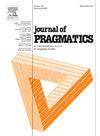Quick body torque toward blackboard at third position: Teachers’ material practice in classroom interaction
IF 1.7
1区 文学
0 LANGUAGE & LINGUISTICS
引用次数: 0
Abstract
Although scholars have illustrated various embodied and material practices in social interactions, they have faced challenges documenting specific collection-based practices across different datasets. Analyzing classroom institutions as an exemplary setting, this paper documents a recurrent embodied and material practice regarding a teacher's use of a blackboard. Specifically, we examined teachers' mobile body torque toward the blackboard at the third position, which signals a positive evaluation of a student's response in the initiation (first)–response (second)–evaluation (third) sequence, known as IRE. Using video recordings of five English-language classrooms in Japan, we conducted multimodal conversation analysis on IRE sequences within a knowledge-check activity involving a blackboard. The activity was organized around teachers' known-answer questions directed to the students. When the teachers obtained a “correct” answer from a student, they quickly moved their bodies toward the blackboard to write the answer while withholding verbal evaluation. At this sequential moment, the teacher's body torque toward the blackboard projects a positive evaluation, along with other embodied conducts, such as a head nod. Terming this practice as the “embodied-material projecting third,” we will demonstrate the recurrence of this embodied and material practice across classrooms. In conclusion, we will discuss how the evaluative action is multimodally constructed through the interplay of the teacher's bodily placement and material engagement in classroom ecology. The data are in Japanese with English translations.
第三位快速转向黑板:教师在课堂互动中的材料实践
虽然学者们已经说明了社会互动中的各种具体和物质实践,但他们面临着跨越不同数据集记录特定的基于收集的实践的挑战。本文以课堂制度为例,记录了教师使用黑板的具体实践和物质实践。具体来说,我们检查了教师在第三个位置向黑板移动的身体扭矩,这标志着对学生在启动(第一)-响应(第二)-评估(第三)序列(称为IRE)中的反应的积极评价。利用日本五个英语课堂的视频记录,我们对涉及黑板的知识检查活动中的IRE序列进行了多模态会话分析。活动围绕教师向学生提出的已知答案问题展开。当老师从学生那里得到一个“正确”的答案时,他们迅速地把身体移到黑板上写答案,而不做口头评价。在这个连续的时刻,老师的身体转向黑板,连同其他具体的行为,如点头,投射出积极的评价。将这种实践称为“具体化的材料投射第三”,我们将展示这种具体化和材料实践在课堂上的反复出现。最后,我们将讨论如何通过教师的身体位置和课堂生态中的材料参与的相互作用,多模态地构建评价行为。数据为日文,附有英文翻译。
本文章由计算机程序翻译,如有差异,请以英文原文为准。
求助全文
约1分钟内获得全文
求助全文
来源期刊

Journal of Pragmatics
Multiple-
CiteScore
3.90
自引率
18.80%
发文量
219
期刊介绍:
Since 1977, the Journal of Pragmatics has provided a forum for bringing together a wide range of research in pragmatics, including cognitive pragmatics, corpus pragmatics, experimental pragmatics, historical pragmatics, interpersonal pragmatics, multimodal pragmatics, sociopragmatics, theoretical pragmatics and related fields. Our aim is to publish innovative pragmatic scholarship from all perspectives, which contributes to theories of how speakers produce and interpret language in different contexts drawing on attested data from a wide range of languages/cultures in different parts of the world. The Journal of Pragmatics also encourages work that uses attested language data to explore the relationship between pragmatics and neighbouring research areas such as semantics, discourse analysis, conversation analysis and ethnomethodology, interactional linguistics, sociolinguistics, linguistic anthropology, media studies, psychology, sociology, and the philosophy of language. Alongside full-length articles, discussion notes and book reviews, the journal welcomes proposals for high quality special issues in all areas of pragmatics which make a significant contribution to a topical or developing area at the cutting-edge of research.
 求助内容:
求助内容: 应助结果提醒方式:
应助结果提醒方式:


